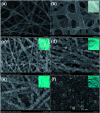Layer-by-layer decoration of MOFs on electrospun nanofibers
- PMID: 35540460
- PMCID: PMC9078903
- DOI: 10.1039/c8ra01260a
Layer-by-layer decoration of MOFs on electrospun nanofibers
Abstract
The design and fabrication of novel organic-inorganic nanocomposite membranes using metal-organic frameworks as building blocks have attracted numerous scientists. Here, HKUST-1 particles were decorated on crosslinked polymer nanofibers through a layer-by-layer method. The immersion sequence, the crosslinking and the number of the deposition cycles have a significant impact on the formation of the HKUST-1 decorated nanofibrous membranes. Moreover, it has been shown that such a membrane could be applied as a catalyst for visual detection of hydrogen peroxide.
This journal is © The Royal Society of Chemistry.
Conflict of interest statement
There are no conflicts to declare.
Figures





Similar articles
-
General Deposition of Metal-Organic Frameworks on Highly Adaptive Organic-Inorganic Hybrid Electrospun Fibrous Substrates.ACS Appl Mater Interfaces. 2016 Feb 3;8(4):2552-61. doi: 10.1021/acsami.5b10078. Epub 2016 Jan 25. ACS Appl Mater Interfaces. 2016. PMID: 26741023
-
Ionic Liquids as the MOFs/Polymer Interfacial Binder for Efficient Membrane Separation.ACS Appl Mater Interfaces. 2016 Nov 23;8(46):32041-32049. doi: 10.1021/acsami.6b11074. Epub 2016 Nov 9. ACS Appl Mater Interfaces. 2016. PMID: 27933967
-
Nanofibrous membranes comprising intrinsically microporous polyimides with embedded metal-organic frameworks for capturing volatile organic compounds.J Hazard Mater. 2022 Feb 15;424(Pt A):127347. doi: 10.1016/j.jhazmat.2021.127347. Epub 2021 Sep 25. J Hazard Mater. 2022. PMID: 34607032
-
Recent trends in electrospinning of polymer nanofibers and their applications in ultra thin layer chromatography.Adv Colloid Interface Sci. 2016 Mar;229:1-24. doi: 10.1016/j.cis.2015.12.003. Epub 2015 Dec 17. Adv Colloid Interface Sci. 2016. PMID: 26792019 Review.
-
Development and Applications of MOFs Derivative One-Dimensional Nanofibers via Electrospinning: A Mini-Review.Nanomaterials (Basel). 2019 Sep 12;9(9):1306. doi: 10.3390/nano9091306. Nanomaterials (Basel). 2019. PMID: 31547339 Free PMC article. Review.
Cited by
-
Innovative cross-linked electrospun PVA/MOF nanocomposites for removal of cefixime antibiotic.Sci Rep. 2025 Jan 2;15(1):83. doi: 10.1038/s41598-024-84818-x. Sci Rep. 2025. PMID: 39747400 Free PMC article.
-
On-Demand Drug Delivery Systems Using Nanofibers.Nanomaterials (Basel). 2021 Dec 16;11(12):3411. doi: 10.3390/nano11123411. Nanomaterials (Basel). 2021. PMID: 34947758 Free PMC article. Review.
-
Polyphenylene Sulfide Ultrafine Viscous Fibrous Membrane Modified by ZIF-8 for Highly Effective Oil/Water Separation under High Salt or Alkaline Conditions.Membranes (Basel). 2022 Oct 20;12(10):1017. doi: 10.3390/membranes12101017. Membranes (Basel). 2022. PMID: 36295776 Free PMC article.
-
Electrospinning of Metal-Organic Frameworks for Energy and Environmental Applications.Adv Sci (Weinh). 2019 Dec 11;7(3):1902590. doi: 10.1002/advs.201902590. eCollection 2020 Feb. Adv Sci (Weinh). 2019. PMID: 32042570 Free PMC article. Review.
-
Introduction and Development of Surface-Enhanced Raman Scattering (SERS) Substrates: A Review.Nanomaterials (Basel). 2024 Oct 14;14(20):1648. doi: 10.3390/nano14201648. Nanomaterials (Basel). 2024. PMID: 39452983 Free PMC article. Review.
References
LinkOut - more resources
Full Text Sources

